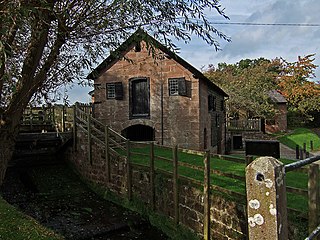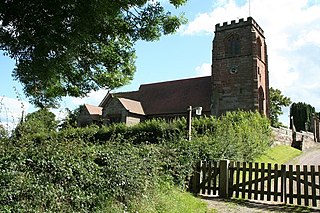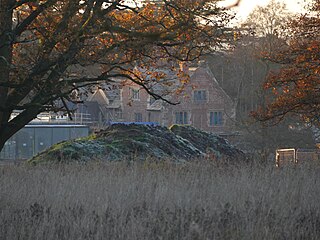Medieval Carden
Carden is not recorded in Domesday Book, as it was probably treated as part of Tilston. In 1066, Tilston had been part of the possessions of Edwin, Earl of Mercia (1065–70), and was evidently already subdivided, as the Bishop claimed half a hide of the manor and, after the Norman conquest, another half hide was sublet to Ranulf Mainwaring. In 1066, the four hides of taxable arable land paid £6, making it one of the most prosperous Cheshire manors. Eight plough-teams could be accommodated on this land; one was in demesne. The recorded population consisted of four villeins, two bordars, four radmen, a reeve, a smith, a miller and two slaves who shared four plough-teams; the mill was worth eight shillings. The manor is described as being one league long and one wide (about 2.4 by 2.4 km); this is reasonable enough for the east–west measurement, but only acceptable for the north–south dimensions if the township of Horton Green is not included.
The origins of a separate manor of Carden are obscure. The descents of the manors through the Middle Ages are complicated by their division into six parts through the coheiresses Leuca, Margaret and Ellen Caurthyn. By 1419/20 Isabel, daughter and heiress of John Beston and widow of Sir Robert Aston held lands in Carden. Her interests in Carden derived from her paternal grandmother, Isabel, daughter of Cecily, heir of John Codinton, presumed descendant of Leuca and Robert Codinton. Two years later Isabel, now married to Sir John Caryngton, obtained more lands in Carden, Farndon, Cuddington, Clutton and elsewhere from Ralph de Beston.
Richard Caurthyn granted his brother William a quarter of Clutton in a charter attested by Robert Stutevile; this may have been the origin of the division of the manor. William's descendants continued to hold land in Carden throughout the Middle Ages, although the failure of one branch of the male line in the reign of Henry IV (1399–1413) brought the manors into new families. His daughter and coheir Eleanor was married to John Leche III, claimed by some to have been a younger brother of the Leche family of Chatsworth, and the manor of Nether Carden was vested in her.
The Leche family had held property in Carden as early as 1346/07, when Eva Warin released land to John Leche I and his wife Lucy, her sister. Their son, John Leche II, is said to have been surgeon to Edward III and given Castle Warin and other lands in County Kildare. Carden Hall descended through thirteen generations of John Leches (although not always father to son), until a William Leche held the manor at the start of the nineteenth century, after which it descended through another three John Leches.
The earliest mention of Carden Hall can be dated to 1570/01, when an inquisitio post mortem of John Leche VIII (who died 21 June 1569) states that he died "seised of a capital messuage called the Hall of Carthen". The construction of the Hall which survived until 1912 probably took place after this date, during the lordship of John Leche IX or John Leche X. On 12 June 1643, Carden Hall was plundered by a detachment from the Parliamentary garrison of Nantwich and took the owner, John Leche X, away with them as a prisoner.
The most picturesque incident during this period was recorded in a handbill published in 1810, which recorded the life of John Harris, known as 'The English Hermit'. [4] The broadsheet makes a great deal of John Harris's piety, and a recent account claims that he preached in the local villages, which seems unlikely given his decision to retire from the company of other human beings.
The manor of Over Carden passed to a younger branch of the Fittons of Bollin by the marriage of Isabel, daughter of William Caurthyn to Thomas Fitton. It remained in the hands of the Fitton family until after 1662, when Owen Fitton was recorded there. Towards the end of the seventeenth century it was sold to the Bradshaws, both families endowing a charity to support a parochial school at Tilston. It later passed to Joseph Worrell, who disposed of it in several lots and the manor passed to the Leche family of Carden Hall, reuniting the two manors under the name Lower Carden. What is now known as Lower Carden Hall became a farmhouse; it survives as a much-restored seventeenth-century building, although the name, somewhat confusingly, does not refer to the manorial residence as it was the manor house of Over Carden.














